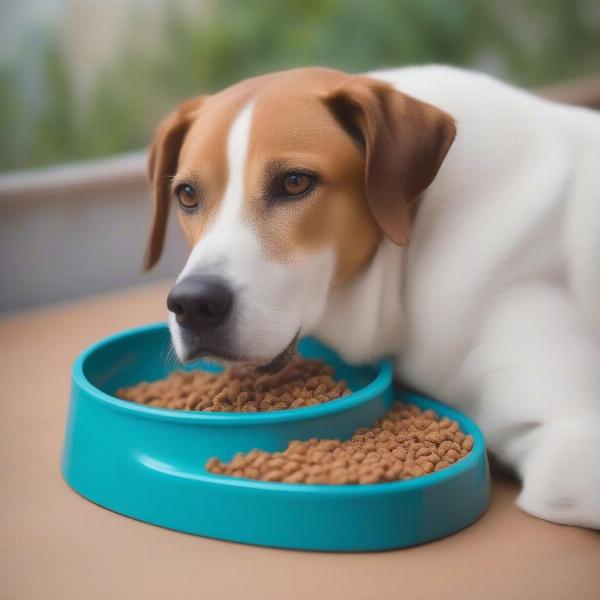Slow feeder dog bowls, or anti-gulp dog bowls, are a simple yet effective solution for dogs who eat their food too quickly. This habit, often referred to as “bolting,” can lead to a range of digestive issues, including vomiting, choking, and even a potentially life-threatening condition called bloat. Using a slow feeder bowl can significantly improve your dog’s mealtime experience, promoting healthier digestion and a more enjoyable eating pace. This guide will help you understand the benefits of slow feeders, choose the right one for your furry friend, and integrate it into their daily routine.
Why Choose a Slow Feeder Dog Bowl?
Speed eating can be a common problem for dogs of all breeds and sizes. By using a slow feeder bowl, you’re actively addressing the potential health risks associated with rapid food consumption. Slow feeders work by creating obstacles within the bowl, forcing your dog to navigate around ridges, mazes, or other raised sections to access their food. This naturally slows down their eating pace, allowing them to properly chew their food and savor their meal. This not only aids digestion but also provides mental stimulation and can even help with portion control for overweight dogs.
How to Choose the Right Slow Feeder
Choosing the right slow feeder can depend on a few factors, including your dog’s breed, size, eating habits, and any specific dietary needs. For smaller breeds, a bowl with smaller obstacles is generally more suitable. Larger breeds might benefit from bowls with larger, more challenging mazes.
- Material: Consider durable materials like stainless steel or food-grade plastic, which are easy to clean and can withstand enthusiastic chewing.
- Design: There are various designs available, from bowls with simple raised sections to more intricate mazes. Choose one that suits your dog’s personality and eating style.
- Size: Select a size appropriate for your dog’s breed and the amount of food they typically consume.
- Non-Slip Base: A non-slip base can prevent the bowl from sliding around during mealtimes, reducing spills and frustration.
Different Types of Slow Feeder Bowls
Understanding the variety of slow feeder designs can help you make the best choice for your dog. Here’s a quick overview:
- Ridged Bowls: These bowls have raised sections or ridges that create obstacles, forcing your dog to eat around them.
- Maze Bowls: These bowls feature a more complex maze-like pattern, offering a greater challenge for determined speed eaters.
- Bloat Stop Bowls: Specifically designed to prevent bloat, these bowls often incorporate larger obstacles and encourage even slower eating.
Introducing a Slow Feeder to Your Dog
Transitioning to a slow feeder bowl should be a gradual process to avoid any anxiety or frustration. Start by mixing a small amount of food in the slow feeder with the rest of their meal in their regular bowl. Gradually increase the proportion of food in the slow feeder until they’re comfortably using it exclusively. Positive reinforcement, such as praise and treats, can encourage your dog to embrace the new bowl.
Benefits Beyond Digestion
anti gulp dog bowl offer more than just digestive benefits. They can also:
- Reduce Bloat Risk: By slowing down eating, they can significantly reduce the risk of bloat, a serious and potentially life-threatening condition.
- Improve Dental Health: Chewing more thoroughly helps clean teeth and gums.
- Mental Stimulation: Navigating the obstacles provides a mental challenge, reducing boredom and promoting engagement.
- Weight Management: Slower eating can increase satiety, helping with portion control and weight management.
 Dog Enjoying a Meal from a Slow Feeder Bowl
Dog Enjoying a Meal from a Slow Feeder Bowl
“Slow feeder bowls are a game-changer for dogs who inhale their food,” says Dr. Emily Carter, DVM. “They not only improve digestion but also offer mental enrichment and contribute to overall well-being.”
Conclusion
Investing in a dog bowl slow feeder is a proactive step towards ensuring your dog’s mealtimes are healthy, enjoyable, and safe. By slowing down their eating pace, you’re minimizing the risk of digestive issues and promoting a more fulfilling dining experience. With a variety of designs and materials available, you can find the perfect slow feeder to suit your dog’s individual needs.
FAQ
- Are slow feeder bowls suitable for all dogs? Yes, slow feeders can benefit dogs of all breeds and sizes, especially those who tend to gulp their food.
- How do I clean a slow feeder bowl? Most slow feeders are dishwasher safe or can be easily washed by hand with soap and water.
- What if my dog refuses to use the slow feeder? Introduce the bowl gradually and use positive reinforcement to encourage acceptance.
- Can slow feeders prevent bloat completely? While they significantly reduce the risk, they don’t guarantee complete prevention. Maintaining a healthy weight and avoiding strenuous exercise after meals are also important.
- Are there different sizes of slow feeders available? Yes, slow feeders come in various sizes to accommodate different breeds and food portions.
- What material is best for a slow feeder bowl? Stainless steel and food-grade plastic are popular choices for their durability and ease of cleaning.
- Can I use a slow feeder for wet food? Yes, many slow feeders are suitable for both wet and dry food.
ILM Dog is a leading international pet website dedicated to providing expert advice on dog care and wellbeing. We offer comprehensive resources on everything from breed selection and health to training, nutrition, and grooming. Our expert-driven content helps dog owners worldwide make informed decisions and provide the best possible care for their furry companions. For further information on dog nutrition, check out our articles on can dog eat lentils and the best dog food for senior dogs. For larger breeds, explore our big dog slow feeder guide. Contact us at [email protected] or +44 20-3965-8624 for personalized advice. Learn more about us at ILM Dog.